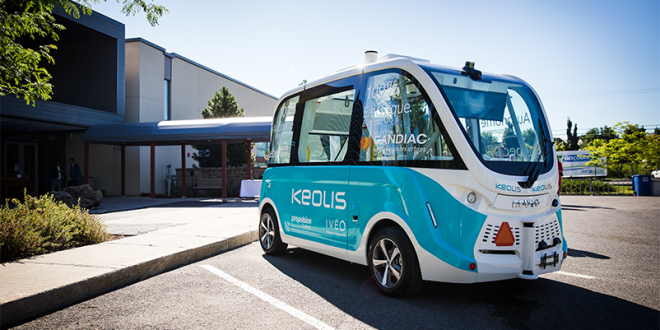The transportation sector has undergone numerous transformations over the centuries, but none as significant as the rise of autonomous public transportation. As urban populations grow and cities become more congested, there is a growing need for more efficient, safe, and sustainable transportation solutions. Autonomous vehicles, particularly in the realm of public transportation, are emerging as a key innovation in addressing these challenges. This blog explores how autonomous public transportation is transforming the future of urban mobility and the benefits it offers.
The Emergence of Autonomous Public Transportation
Autonomous public transportation involves self-driving buses, shuttles, and other public vehicles that operate without human intervention. These vehicles use advanced sensors, cameras, radar systems, and artificial intelligence to navigate roads, detect obstacles, and make real-time decisions. The concept of autonomous public transportation is no longer limited to science fiction; cities across the world are already experimenting with self-driving public buses and shuttles.
This technology is designed to improve the efficiency of public transportation by eliminating human error, reducing traffic congestion, and providing consistent service. By removing the need for human drivers, autonomous public transport can offer more predictable and reliable schedules, addressing some of the common complaints about current systems, such as delays and unpredictable routes.
Safety and Efficiency: The Core Advantages
One of the most significant advantages of autonomous public transportation is the improvement in safety. Human error is a leading cause of accidents, and autonomous systems are designed to minimize this risk. By using sensors and real-time data, self-driving public vehicles can detect hazards far more quickly than human drivers and respond appropriately, whether it’s a pedestrian crossing the street or another vehicle making an unexpected move. These vehicles follow traffic rules with precision and are less likely to engage in risky behaviors such as speeding or distracted driving.
Additionally, autonomous vehicles can optimize routes, ensuring that they take the most efficient paths to their destinations. This reduces traffic congestion and travel times, allowing passengers to reach their destinations faster. By analyzing traffic patterns in real-time, these vehicles can adjust their routes to avoid roadblocks or heavy traffic, further improving efficiency.
Autonomous Public Transportation Boosting the Cash for Cars Industry
As autonomous public transportation grows in popularity, it is influencing the cash for cars and junkyard industry. With more people relying on self-driving buses and shuttles, the demand for private vehicles is expected to decrease. This shift encourages individuals to sell their unwanted cars, driving up the need for services like cash for car wrecker Sydney. The increase in vehicle disposal contributes to more efficient recycling and repurposing in the junkyard industry, aligning with the sustainability goals of autonomous transportation systems.
Environmental Impact and Sustainability
Another significant benefit of autonomous public transportation is its potential contribution to environmental sustainability. Many autonomous vehicles, especially public transport systems, are designed to be electric. This transition from traditional gasoline-powered buses and shuttles to electric autonomous vehicles can dramatically reduce carbon emissions in urban areas.
In addition to reducing emissions, autonomous public transport systems also encourage the use of shared transportation, further reducing the number of private vehicles on the road. Fewer vehicles mean less congestion and a lower environmental footprint for urban mobility. The ability to run autonomous shuttles and buses more frequently also reduces the need for people to rely on individual car ownership, promoting more sustainable transportation choices in cities.
Accessibility and Inclusivity
Autonomous public transportation has the potential to make cities more inclusive and accessible. For individuals who are unable to drive due to age, disability, or other reasons, self-driving buses and shuttles provide a valuable alternative for independent travel. Autonomous vehicles can be designed with accessibility features such as ramps and voice-activated systems to assist passengers with mobility challenges.
This form of transportation also has the ability to run on demand, ensuring that underserved communities or areas with limited transportation options are connected to the wider city. Autonomous public transport systems can be programmed to serve both high-demand urban centers and lower-demand suburban or rural areas, creating a more equitable distribution of services.
Also visit: https://cashforcarsnsw.com.au/cash-for-cars-bella-vista/
Cost-Effectiveness and Economic Impact
The economic benefits of autonomous public transportation are also worth noting. While the initial investment in autonomous vehicle technology and infrastructure is substantial, the long-term savings can be significant. Without the need to pay human drivers, transportation authorities can reduce labor costs. Autonomous vehicles also tend to require less maintenance since they are programmed to drive more efficiently and avoid aggressive driving behaviors that can wear down vehicles faster.
For cities, investing in autonomous public transportation can also lead to indirect economic benefits. Reduced traffic congestion can boost productivity by allowing people to spend less time commuting. Furthermore, with fewer accidents and improved traffic flow, cities can save on emergency response costs and infrastructure repair.
Overcoming Challenges and Barriers
Despite the clear benefits, there are still several challenges to overcome before autonomous public transportation becomes widespread. One of the key barriers is the need for robust regulatory frameworks to ensure that autonomous vehicles are safe for public use. Governments must establish clear guidelines for the testing and deployment of self-driving public transport systems, taking into consideration the safety of both passengers and pedestrians.
Additionally, public acceptance of autonomous vehicles is another hurdle. Some individuals may be hesitant to trust self-driving technology, particularly when it comes to public transportation. Educational campaigns and pilot programs can help build confidence in the reliability and safety of autonomous systems, gradually increasing public trust.
Finally, the development of infrastructure that supports autonomous public transportation is essential. This includes creating smart roads equipped with sensors, traffic management systems, and charging stations for electric autonomous vehicles. Urban planning must also be adapted to accommodate the unique needs of autonomous transportation.
The Future of Autonomous Public Transportation
Looking ahead, the future of autonomous public transportation is bright. As technology continues to improve and regulatory frameworks evolve, we can expect to see an increasing number of cities adopting autonomous systems for their public transportation networks. From small self-driving shuttles operating in city centers to large autonomous buses on highways, this technology will play a critical role in reshaping urban mobility.
Autonomous public transportation is likely to be integrated with other smart city initiatives, creating a seamless network of connected and intelligent transport systems. This will result in more efficient, sustainable, and accessible transportation for urban populations around the world. Furthermore, as autonomous systems become more affordable, smaller cities and rural areas may also begin to benefit from these advancements, creating a more interconnected transportation network across regions.
Conclusion
Autonomous public transportation represents a significant leap forward in the evolution of urban mobility. By improving safety, efficiency, and accessibility while reducing environmental impact, self-driving public vehicles offer a solution to many of the challenges facing modern cities. Although there are still regulatory and technological hurdles to overcome, the potential benefits of autonomous public transportation make it a promising development for the future of mobility.
As more cities adopt this technology, autonomous public transportation will play a central role in creating more sustainable, efficient, and inclusive transportation systems. This innovation is not only transforming how we move around urban areas but also contributing to a greener, safer, and more connected future.
Visit Our Website to Discover More
 Crypto trade Online Unlock the Future of Finance Today.
Crypto trade Online Unlock the Future of Finance Today.




